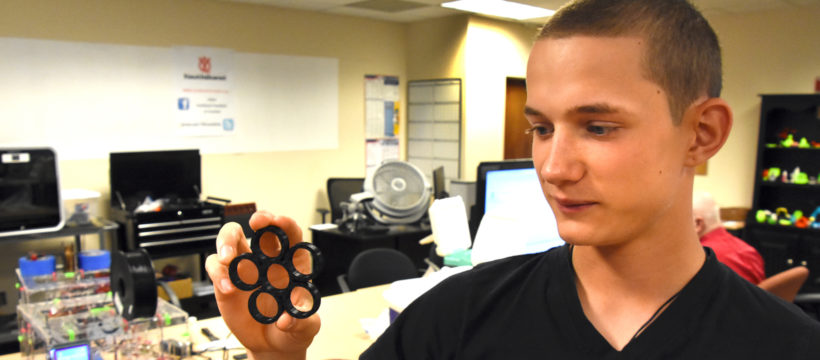Considering what many of the at-risk teens our 3D ThinkLink Initiative serves have been through in their young lives, it’s remarkable that they’ve done as well as they have. Violence, poverty, family upheaval, academic failure, substance abuse and all sorts of physical and emotional trauma are recurring themes in their personal stories. Yet some of them thrive despite it all.
This quality of being able to succeed in the face of adversity is known as resilience.
One of the unexpected discoveries we’ve made during five years of teaching 3D design and printing to troubled kids is that the experience helps many of them become more resilient.
That’s because our program emphasizes more than technical skills. It promotes critical thinking, problem solving, creativity and self-confidence. The trial-and-error process of making 3D-printed objects changes our students’ perception of failure. They come to see it as a natural part of the learning process and a step along the path to eventual success.
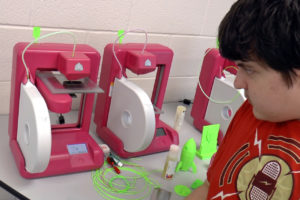
“These are students that have failed often in the classroom and they don’t always have the confidence that they can learn and be successful. The 3D class really gives them that,” said Lindsay Harris, director of the Career Partners Program at PHILLIPS Programs for Children and Families. PHILLIPS has adapted our 3D ThinkLink curriculum for students with autism at its Annandale and Fairfax, Virginia, schools.
“Trying something hard, being successful and becoming competent in it, going through a process where your design fails but then problem-solving to improve the design so that it prints the way you want it … This all has a major impact on their self-esteem and their confidence that they can contribute, they can learn, they can problem-solve,” she added. “We know from the resiliency literature that having successful experiences is one of the ‘protective factors’ that shield you from stresses in life. So this definitely is something that helps build their resiliency.”
Relationships Overcome Risks
“Resilient people defy stereotypes,” explained Associate Professor Elizabeth Anthony from the Arizona State University School of Social Work. In a 2016 speech, she advocated defining children by their strengths instead of their risks.
Anthony, who’s spent two decades studying how some children manage to do well despite adversity, has found that relationships are a key factor.
“It could be a mentor, for example, who helps a young person identify a gift or a talent, that helps inspire them,” she said.
At-risk kids develop more resilience when someone takes an interest in them and “champions their cause,” Anthony added.
A long-running study of children on the Hawaiian island of Kauai that began more than 60 years ago reinforces Anthony’s point. According to an article by Lucy Maddox on the website Quartz:
The researchers in the Kauai study separated the nearly 700 children involved into two groups. Approximately two-thirds were thought to be at low risk of developing any difficulties, but about one-third were classed as “high-risk”: born into poverty, perinatal stress, family discord (including domestic violence), parental alcoholism or illness. they found that two-thirds of this group went on to develop significant problems. But totally unexpectedly, approximately one-third of the “high-risk” children didn’t. They developed into competent, confident and caring individuals, without significant problems in adult life.
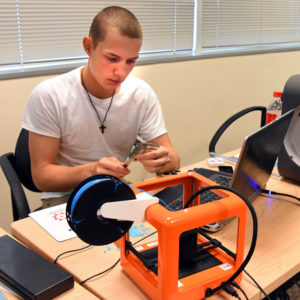
“One person can make a big difference,” the study’s principal investigator Lali McCubbin, told Maddox. “A lot of the research supports this idea of relationships, and the need to have a sense of someone that believes in you or someone that supports you – even in a chaotic environment – just having that one person.”
Jonathan Brown and Jamarr Dennis experienced this as a 3D ThinkLink instructors at Maryland’s Freestate ChalleNGe Academy last year, when one of their students was David Kelly, who lives in tough, inner-city part of Baltimore.
“In his family and neighborhood, it would be so easy for him to fall back into what he got away from. But this kid separated himself from all the commotion, all the folks who wanted to continue to go down the wrong path, who tried to use peer pressure and other methods to get him off the path,” said Brown. “His commitment to complete the program was unparalleled. Being in 3D couldn’t have been a better experience for him, to see someone believing in him and being successful doing it.”
“He watched me print out a chess piece and that opened his eyes,” Dennis recalled. “He said I want to do the same thing you just did, but I want to do it from scratch. And then from there on, he just started progressing. He was so excited about it. … It turned on that inspiration, that ambitiousness, that he has.”
“Afterwards he gave me the biggest hug you could give anybody and said thank you for being patient with me, especially teaching me in this class,” added Dennis.
Kelly turned out to be one of the top 3D students in his class at Freestate and went on to attend advanced training in the 3D ThinkLink Creativity Lab at our headquarters in Chantilly, Virginia, last summer. This month, he enlisted in the Delayed Entry Program and is on his way to fulfilling his dream of becoming a U.S. Marine.
Competence Creates Confidence
The at-risk teens we serve typically have very limited life experiences, and what experiences they do have are overwhelmingly negative. As a result, their view of what’s possible for them is also limited. That’s why our 3D ThinkLink Initiative is designed to expose these young people to new ideas and experiences. For instance, each class cycle includes Vocational Orientation tours that take students to places they’ve never been and show them how the 3D skills they’re learning in class are used by businesses and universities.
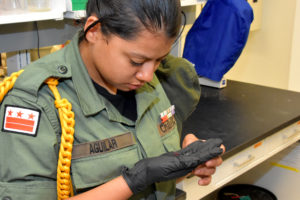
“One of the most exciting findings in the last decade or so is that we can change the wiring of the brain through the experiences we expose it to. The right experiences can shape the individual, intrinsic characteristics of a child in a way that will build their resilience,” psychologist Karen Young wrote on the website Hey Sigmund.
Experiences that show at-risk kids they’re capable of doing difficult things can be life-changing, Young added. Developing competence and “a sense of mastery” strengthens their resilience.
3D design and printing seems daunting to our students when they begin class. Most of them have told us they didn’t think they could do it at first. But the teachers guide them step-by-step through the 3D ThinkLink curriculum, showing them how to solve problems through critical thinking and iterative improvement. Although they experience plenty of failures while designing and printing 3D objects, they learn from those mistakes and keep trying until they’re successful.
The overarching lesson of our program that failure is not final – in 3D printing and in life. It’s gratifying when we see at-risk kids take that lesson to heart.
One of those who did is Daniela Aguilar from Washington, DC, who was in our 3D class at Capital Guardian Youth ChalleNGe Academy during the first half of last year. She fell one test short of earning her General Equivalency Diploma (GED), so the school asked her to come back for the next class cycle to serve as peer mentor, which gave her the chance to stay on campus and finish her GED.
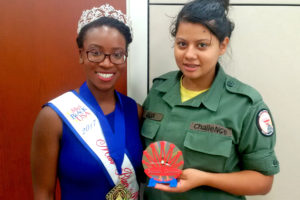
“She was young — 16 when she came to us in January – and had a difficult home life. That’s one of the reasons we allowed her to become a peer mentor, to keep her in a better environment for a little while longer to accomplish her goal of completing her GED,” said Keith Hammond, who teaches 3D ThinkLink classes at Capital Guardian.
When Miss Black Maryland USA Saidah Grimes visited the campus last August, a counselor asked if Hammond’s class could make a 3D-printed keepsake. Because Aguilar had completed 3D ThinkLink training in the previous class cycle, Hammond assigned her the task of designing and printing a customized clock for the VIP guest.
“In the beginning, she thought being back at Capital Guardian as a peer mentor would make people think of her as a failure because she hadn’t passed her GED. But because she got the spotlight by knowing 3D printing, making the clock and presenting it in front of everyone, she felt better about herself,” said Hammond. “When she got that positive reinforcement because she knew how to do the 3D program, I think it made her understand internally that she is worth the effort.”
